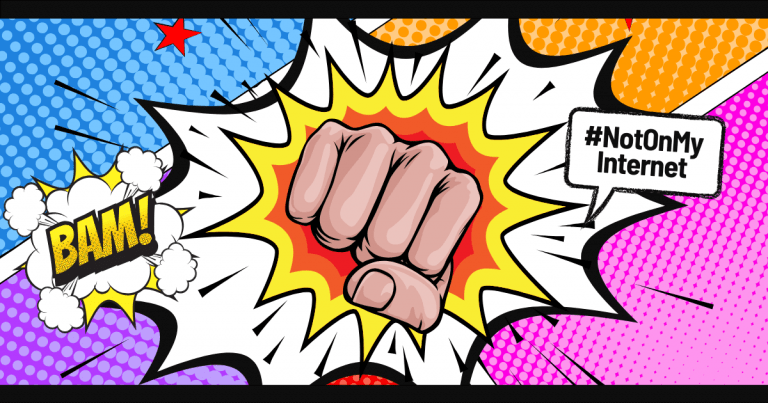5 Positive Strategies to Counter Hate Speech Online
CyberShield
Is your nonprofit working with vulnerable or marginalized communities? CyberShield is a free, self-paced online course built specifically for nonprofits to recognize, respond to, and prevent hate speech online. With real-world examples, legal context, and actionable strategies tailored to Canadian organizations, you’ll learn how to protect your team, community, and platforms. Complete the course to earn a CyberShield Certificate and access tools like our customizable Online Hate Mitigation Policy.
Register through CybersafetyAcademy.org to get started.

Have you ever been scrolling through your social media feed, looking at the usual interesting posts and updates from friends, when you suddenly stumble upon someone making shocking and derogatory remarks about people of a certain identity group? Perhaps you or someone you know has even been subjected to this kind of hateful online conduct personally. In either case, you have witnessed hate speech online, an increasingly pervasive issue affecting people worldwide.Have you ever been scrolling through your social media feed, looking at the usual interesting posts and updates from friends, when you suddenly stumble upon someone making shocking and derogatory remarks about people of a certain identity group? Perhaps you or someone you know has even been subjected to this kind of hateful online conduct personally. In either case, you have witnessed hate speech online, an increasingly pervasive issue affecting people worldwide.
In response to this growing problem, the United Nations created the International Day for Countering Hate Speech, an annual observance dedicated to raising awareness about the dangers of hate speech and promoting efforts to identify and combat it. Every June 18, the UN invites governments, organizations and individuals to discuss and develop strategies to combat this issue. We have created this guide on taking a stand against hate speech online, because at KnowledgeFlow we are committed to helping people feel safe and secure online.
Understanding Hate Speech Online
Hate speech refers to any type of communication that attacks or uses discriminatory language against a person or group of people based on a factor of their identity such as their ethnicity, religion, race, sexual orientation or gender. Hate speech may be expressed through spoken or written words, but also through memes, cartoons and other media.
Hate speech online could consist of a post describing a group as intrinsically lesser than other groups, or a meme that perpetuates a conspiracy theory accusing a group of controlling society. It is important to understand the impact of hate speech and that it is much deeper than simply cruel words.
Hate speech online has been linked to an increase in violence against people belonging to marginalized groups and, on numerous occasions, has been connected to real-life acts of violence. Countering hate speech online is critical in ensuring everyone feels safe both online and in the real world.

What you can do
While it is understandable to feel powerless to combat the proliferation of hate speech online, there are steps that every individual can take to have an impact and make the internet a safer place. Below are 5 things that you can do to take a stand against hate speech.
recognize
The first step in countering hate speech is recognizing it when it takes place. With such a broad definition, it can sometimes be difficult to determine if what you are witnessing is hate speech. The Social Science Research Council has identified three major categories of hate speech.
- Dehumanization and Demonization: The first involves either dehumanizing members of a group by referring to them as less than human, or demonizing them as a superhuman threat that must be dealt with. Both of these techniques can serve as tools to justify violence and persecution.
- Violence and incitement: The second category involves an incitement to violence against members of a group.
- Early Warning: The third is a category that exists on the border of hate speech and is described as an “early warning” stage—it does not necessarily involve dehumanization or violent language, but the subtler act of distinguishing between “us” and “them,” which can lead to broad negative generalizations about a group and function as a stepping stone to more dangerous speech and actions.
Respond
A key step in countering hate speech online is to respond to it. It is critical that perpetrators not feel like they have free reign to spread hate speech unchallenged, so if you feel comfortable doing so, you can call out hate speech by spreading messages of tolerance. If perpetrators are spreading hateful disinformation, you can take the time to research these claims and make fact-based rebuttals. While you may not change the minds of the people spreading hate speech, you may end up dissuading others from being misled by the deceptive claims.
Support
When countering hate speech, the goal is always to ensure the safety and comfort of those who have been victimized. Therefore, if you encounter hate speech online, it is important to show your support for groups and individuals that are being targeted. Showing solidarity with marginalized groups and providing support to individuals you know or encounter who have been targeted with hateful conduct online is a key part of creating a safer online environment for everyone.
Report
A powerful tool in the arsenal of countering hate speech is the report button. Most social media platforms have a button to report posts or accounts that violate their code of conduct, usually with an option to specify the nature of the report as being due to hateful conduct. While reporting a hateful post does not guarantee that it will be taken down, making a habit of reporting every post you see that contains hate speech makes it more likely for perpetrators to face consequences.
Additionally, if you are ever victimized by hate speech online or simply do not want to see a hateful account after reporting their post, do not hesitate to block them. Blocking hateful accounts is an easy way to create a safer and more comfortable environment for yourself online.
Learn
The final step in countering hate speech is to always stay informed. Being aware of the harms of hate speech and sharing that knowledge with the people you know can help to create a culture that is aware and unaccepting of hateful conduct. Below are some helpful resources to help you get started in learning more about hate speech, as well as the International Day for Countering Hate Speech.
An introduction to the International Day for Countering Hate Speech
International Day for Countering Hate Speech | United Nations
An overview of the issue of online hate speech and a comparison of various countries’ responses
Hate Speech on Social Media: Global Comparisons | Council on Foreign Relations (cfr.org)
An explanation of the three major categories of hate speech
Classifying and Identifying the Intensity of Hate Speech – Items (ssrc.org)
A report on exposing and mitigating online hate against 2SLGBTQ+ organizations
The Internet Isn’t All Rainbows (odlan.ca)






